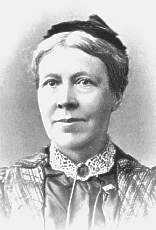
Isabella Tod
The introduction of the Intermediate Education (Ireland) Act (1878) and the Royal University of Ireland Act (1879) provided the real breakthrough in girls' secondary education in Ireland as, for the first time, they established the principle that girls and women had the right to sit for public competitive examinations and to take university degrees.
From the early 1870s there had been a growing demand in Ireland for a competitive examinations system which would allow Catholics in particular to enter for the newly created jobs in the civil service and for careers in the professions. In response to this pressure, the Irish Intermediate Education Bill was introduced to parliament in 1878. It provided an Examining Board with an annual sum of £32,500 per annum which would cover money prizes for pupils and results fees for schools. Students with the highest marks could gain valuable exhibitions worth up to £50. But these provisions would apply only to boys.
The Bill was in its final stages in parliament, when Isabella Tod of the Ladies' Institute, Belfast, arrived with a small delegation of women backed by a handful of Irish MPs, to demand that girls should also be included in the provisions of the Bill. Fortunately, attitudes among a majority of English MPs were favourable to the inclusion of girls in the Bill. The most influential of these MPs was Mr Gladstone (the leader of the Liberal Party) who thought that the proposal to admit women to the benefits of the Bill was reasonable and fair. Although not in favour of giving women the vote, he was prepared to admit that, 'we have on the whole done rather less than justice to women as compared to men' when it came to education.
Mr Meldon (MP for Kildare) strongly objected to what he called 'the victory' which the inclusion of girls would give to the advocates of women's rights, 'whose object was not that there should be a limited measure dealing specially with the education of women, but that the same education should be given to girls as given to men.'
| Mr O'Shaughnessy (the only Home Rule MP on Isabella Tod's delegation) assured Mr Meldon that the question at stake was not one of women's rights but simply of their education and that the object of the amendment 'was nothing more nor less than to educate the women of Ireland that they may be better able to discharge their duties as daughters, wives and mothers.' This line of argument was also used by Mr Stansfield, an English MP included in Isabella Tod's delegation: 'It was enough to say that the girls of to-day would be the mothers of a future generation of men, and that the strongest educational influences were exercised over both boys and girls by mothers, in order to satisfy all reasonable people that men equally with women, were interested in justice being done to girls in that or in any other educational measure.' |  Isabella Tod |
So, despite the strong objections of most Irish Home Rule MPs, girls were included in the Intermediate Examination Act. Isabella Tod at a meeting in Dublin to promote the extension of the franchise to women thanked Mr O'Shaughnessy (Home Rule MP) and James Stansfield, MP for their support but declared, 'We could not help feeling how easy our task would have been if each of these members had owed some votes to women and felt a distinct responsibility to them.'
The unease felt about public competitive examinations for girls in Ireland was expressed by Mr Haughton who had played a leading part in opening the College of Physicians in Dublin to women. He believed that the competitive idea ought to be 'most carefully excluded from the examinations for women.' He also urged the ladies present at the suffrage meeting to press the government to avoid publishing the names of girls in order of merit, 'Let the competitive spirit cease.'
This attitude helps explain why it was felt that girls were not ready to compete on an equal basis with boys. In December 1878, the Intermediate Board decided that girls would compete among themselves for the money prizes. A money prize was offered for every ten pupils who passed. These prizes were, therefore, allocated proportionately according to the numbers of boys and of girls who entered for the examinations. During the first twenty years of the Intermediate examinations, three quarters of the entrants were boys and only one quarter were girls. Girls' schools, especially convent schools, were particularly handicapped because they had few teachers who knew Latin or Greek and extra marks were allotted for other traditional boys' subjects such as Mathematics.
The Intermediate examinations had three levels: Junior, Middle and Senior Grades with strict age limits of under 16, 17 and 18 years of age respectively. This represented a problem for girls' schools since many girls came late to second level schools, being often 14 or 15 years of age.
The fact that public opinion in Ireland was at first generally against such examinations for girls and that many girls had neither the opportunity nor the means to take immediate advantage of the Act, does not alter its crucial importance as a catalyst for changing the role of women in Irish society.